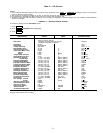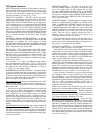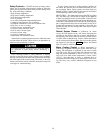
PIC System Functions
NOTE: Throughout this manual, words printed in capital let-
ters and italics represent values that may be viewed on the
LID. See Table 2 for examples of LID screens. Point names
are listed in the Description column. An overview of LID
operation and menus is given in Fig. 13-19.
CAPACITY CONTROL — The PIC controls the chiller
capacity by modulating the inlet guide vanes in response to
chilled water temperature changes away from the CON-
TROL POINT. The CONTROL POINT may be changed by
a CCN network device, or is determined by the PIC adding
any active chilled water reset to the ECW (Entering Chilled
Water) SET POINT or LCW SET POINT. The PIC uses the
PROPORTIONAL INC (Increase) BAND, PROPORTIONAL
DEC (Decrease) BAND,and the PROPORTIONAL ECWGAIN
to determine how fast or slow to respond. CONTROL POINT
may be viewed/overridden on the Status table, Status01
selection.
ENTERING CHILLED WATER CONTROL — If this op-
tion is enabled, the PIC uses ENTERING CHILLED WATER
temperature to modulate the vanes instead of LEAV-
ING CHILLED WATER temperature. ENTERING CHILLED
WATER control option may be viewed/modified on the Equip-
ment Configuration table, Config table.
DEADBAND — This is the tolerance on the chilled water/
brine temperature CONTROL POINT. If the water temper-
ature goes outside of theDEADBAND, the PIC opens or closes
the guide vanes in response until it is within tolerance. The
PIC may be configured with a 0.5 to 2 F (0.3 to 1.1 C) dead-
band. DEADBAND may be viewed or modified on the Equip-
ment Service1 table.
For example, a 1° F (0.6° C) deadband setting controls
the water temperature within ±0.5° F (0.3° C) of the con-
trol point. This may cause frequent guide vane movement if
the chilled water load fluctuates frequently. A value of
1° F (0.6° C) is the default setting.
PROPORTIONAL BANDSAND GAIN — Proportional band
is the rate at which the guide vane position is corrected in
proportion to how far the chilled water/brine temperature is
from the control point. Proportional gain determines how
quickly the guide vanes react to how quickly the tempera-
ture is moving from CONTROL POINT.
The proportional band can be viewed/modified on the LID.
There are two response modes, one for temperature re-
sponse above the control point, the other for response below
the control point.
The first type is called PROPORTIONAL INC BAND, and
it can slow or quicken vane response to chilled water/
brine temperature above DEADBAND. It can be adjusted
from a setting of 2 to 10; the default setting is 6.5. PRO-
PORTIONAL DEC BAND can slow or quicken vane re-
sponse to chilled water temperature below deadband pluscontrol
point. It can be adjusted on the LID from a setting of 2 to 10,
and the default setting is 6.0. Increasing either of these set-
tings will cause the vanes to respond slower than at a lower
setting.
The PROPORTIONAL ECW GAIN can be adjusted at the LID
display from a setting of 1.0 to 3.0, with a default setting of
2.0. Increase this setting to increase guide vane response to
a change in entering chilled water temperature. The propor-
tional bands and gain may be viewed/modified on the Equip-
ment Service3 table.
DEMAND LIMITING — The PIC will respond to the
ACTIVE DEMAND LIMIT set point by limiting the open-
ing of the guide vanes. It will compare the set point
to either COMPRESSOR MOTOR LOAD or COMPRES-
SOR MOTOR CURRENT (percentage), depending on how
the control is configured for the DEMAND LIMIT SOURCE
which is accessed on the SERVICE1 table. The default set-
ting is current limiting.
CHILLER TIMERS — The PIC maintains 2 runtime clocks,
known as COMPRESSOR ONTIME and SERVICE ON-
TIME. COMPRESSOR ONTIME indicates the total life-
time compressor run hours. This timer can register up
to 500,000 hours before the clock turns back to zero. The
SERVICE ONTIME is a resettable timer that can be used to
indicate the hours since the last service visit or any other
reason. The time can be changed through the LID to
whatever value is desired. This timer can register up to
32,767 hours before it rolls over to zero.
The chiller also maintains a start-to-start timer and a stop-
to-start timer. These timers limit how soon the chiller can be
started. See the Start-Up/Shutdown/Recycle Sequence sec-
tion, page 39, for operational information.
OCCUPANCYSCHEDULE — Thisschedule determines when
the chiller is either occupied or unoccupied.
Each schedule consists of from one to 8 occupied/unoccupied
time periods, set by the operator. These time periods can be
enabled to be in effect, or not in effect, on each day of the
week and for holidays. The day begins with 0000 hours and
ends with 2400 hours. The chiller is in OCCUPIED mode
unless an unoccupied time period is in effect.
The chiller will shut down when the schedule goes to UN-
OCCUPIED. These schedules can be set up to follow the
building schedule or to be 100% OCCUPIED if the operator
wishes. The schedules also can be bypassed by forcing the
Start/Stop command on the PIC Status screen to start. The
schedules also can be overridden to keep the unit in an OC-
CUPIED mode for up to 4 hours, on a one-time basis.
Figure 18 shows a schedule for a typical office building
time schedule, with a 3-hour, off-peak cool down period
from midnight to 3 a.m., following a weekend shutdown.
Example: Holiday periods are unoccupied 24 hours per day.
The building operates Monday through Friday, 7:00 a.m. to
6:00 p.m., with a Saturday schedule of 6:00 a.m. to
1:00 p.m., and includes the Monday midnight to 3:00 a.m.
weekend cool-down schedule.
NOTE: This schedule is for illustration only, and is not in-
tended to be a recommended schedule for chiller operation.
PSIO Software Version 08 and Lower — Whenever the chiller
is in the LOCAL mode, the chiller will start when the
Occupancy Schedule 01 indicates OCCUPIED. When in the
CCN mode, Occupancy Schedule 02 is used.
PSIO Software Version 09 and Higher — The Local Time
Schedule is still the Occupancy Schedule 01. The Ice Build
Time Schedule is Schedule 02 and the CCN Default Time
Schedule is Schedule 03. The CCN schedule number is de-
fined on the Config table in the Equipment Configuration
table on page 23. The schedule number can change to any
value from 03 to 99. If this schedule number is changed on
the Config table, the operator must use the Attach to Net-
work Device table to upload the new number into the Sched-
ule screen. See Fig. 17.
28


















